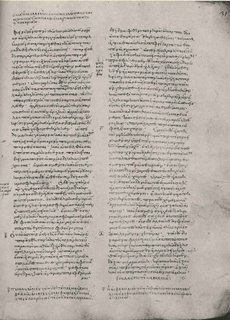
Subscribe to:
Post Comments
(
Atom
)
A forum for people with knowledge of the Bible in its original languages to discuss its manuscripts and textual history from the perspective of historic evangelical theology.
Since I have transcribed this very page (Jude) and know the text very well, I could identify it quickly. I will not spoil the fun, but when I saw v. 24...
ReplyDeleteAs is evident from the photo, Jude was subdivided in four chapters (κεφαλαια) which are indicated with Α, Β, Γ, Δ (A begins with v. 1, not on the photo).
ReplyDeleteIn the margins of this MS, the headings of the μαρτυριαι are indicated. Hatch says of the μαρτυραιαι:
"The writers of the New Testament regarded the books of the Old Testament as divinely inspired and sacred, and they quoted Old Testament passages frequently in their works. In codices of the New Testament it was customary to indicate the Old Testament quotations (μαρτυριαι) for the benefit of the reader. This was done by means of asterisks or other marks placed in the margin alongside of the passage quoted." (Facsimiles and Descriptions of Minuscule Manuscripts of the New Testament [Harvard University Press, 1951], 26.
Interestingly, the μαρτυριαι are not only quotations from the Old Testament; in MSS of the Epistle of Jude, I have found that most often the citation of the extra-canonical prophecy of Enoch (vv. 14-15) is marked as a μαρτυρια, often with the sign ">" (not in the MS on this photo), whereas the account of the dispute between the devil and Michael (v. 9), where Michael rebukes the devil with επιτιμησαι σοι κυριος, is not marked, but both the headings are very often indicated in the margin, Μωυσεως αποκρυφου (v. 9) and Ενωχ αποκρυφου (vv. 14-15).
Tommy,
ReplyDeleteIt would be interesting to know whether the marturia marks on the Enoch quote in Jude are the same as the marks used by the same copyists for other books. Do you know the answer to this? (I.e. how many copyists regarded the Enoch quote and OT quotes in adjacent NT books in the same light? I suppose Rev. 1.7 is the nearest neighbour.)
Simon
Sjgathers:
ReplyDelete"how many copyists regarded the Enoch quote and OT quotes in adjacent NT books in the same light?"
The Enoch quote is marked in the majority of the manuscripts, and I would say that it is firmly established among the μαρτυριαι.
In one manuscript I found at the beginning of the codex an extensive list of all μαρτυριαι in the New Testament, where Ενωχ αποκρυφου was indicated (and I think also Μωυσεως αποκρυφου-I will have to look that up).
Interestingly, in a few MSS, the apostolic prophecy in v. 18 is also marked (but there is never any heading).
I have looked up things in my files. These are the various data for the Epistle of Jude:
ReplyDeleteαναγνωσις μια
κεφαλαιων δ (αβγδ)
μαρτυριων β (αβ)
στιχων ξη̅
The first feature αναγνωσις or αναγνωσμα seems to differ between MSS (there seems to be either one or two readings from Jude).
The μαρτυριαι also known as παλαι μαρτυριαι are sometimes indicated in a separate list in an MS. For Jude there are two: (α) μωυσεως αποκρυφου, followed by the citation επιτιμησαι σοι κς̅, and then (β) ενωχ αποκρυφου ιδου ηλθεν ... κατ' αυτου.
Hatch suggested that the μαρτυριαι were from the Old Testament. This is a generalization. In the Catholic Epistles, there are 19 from the OT, but 3 from the Gospels (Matthew and John) and 2 from "apocrypha" (in Jude).
Okay, it has been a week since PH started the seminar, so:
ReplyDeleteThe MS is Vat. gr. 1650 = Gr.-Al. 623, dated to 1037.
In Jude v. 24 (see image) it reads στηριξαι κατενωπιον της δοξης αυτου
There are just a few witnesses that support στηρίξαι (0316 5 623 2805 L:S) in v. 24 which is why I could identify the MS rather fast. This reading may represent an assimilation to the doxology of Romans, τῷ δὲ δυναμένῳ ὑμᾶς στηρίξαι (traditionally in Rom 16:25).
According to the Editio Critica Maior, the recently registered uncial 0316 reads either στησαι or στηριξαι. However, I have examined new images of this MS and there is no doubt that it reads στηριξαι. BTW, in my dissertation I publish complete plates of 0316 (Coptic and Greek).
Thanks Peter and Tommy. I am a late comer but appreciated your presentation.
ReplyDeleteMalcolm